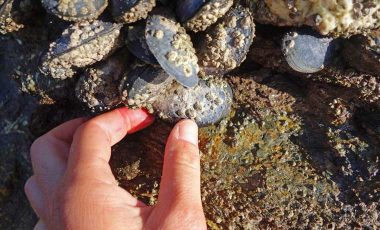Unless you have the luxury of time and space to grow all your own veggies, eating sustainably and ethically is no easy task. That said, there are loads of ways in which we can make changes, like simply eating more vegetables and less meat. And for those living close to the coast, nothing beats foraging for mussels when it comes to sustainable protein. Foraging for mussels that naturally grow in the wild takes sustainable practices to the next level. But only if it is done responsibly and sparingly.
However, if you don’t have easy access to wild mussel beds to forage from responsibly, then opting for farmed mussels is still an excellent choice, from a sustainability point of view. Farmed mussels are a much better choice than farmed fish as they don’t require feeding in the same way that carnivorous fish, like salmon, do. Plus, mussel farms have a much lower impact on the wild ecosystems that surround them.
So grab your wellies and head to shore to gather a very eco-friendly and highly delicious wild meal!
- Top tips on foraging for mussels
- A step by step guide to foraging for mussels
- Ale and ginger camping mussels
Top tips on foraging for mussels
01Forage during the right season
In the UK, the best time to forage for mussels is between September and April. The summer is breeding time, so it’s essential that they are left well alone during this time to grow.
The best time to go foraging for mussels differs, depending on where you are in the world. So be sure to do your research in your local area before you go plucking off all the new-borns.
02Check water quality
To ensure that the mussels are as fresh and unpolluted as possible, it’s a good idea to check the water quality before you head out foraging. In general, river and stream inlets should be avoided as there is often extra pollutants in the water coming off the land, or worse. Also avoid mariners and harbours, or areas with heavy boat traffic.
Check that there are no obvious drainage outlets in the area you intend foraging in, and avoid rock pools that may be above the high tide line.
Here are a few places to start to check the water quality:
03Go at the right time
The best time to harvest mussels is at low tide as the mussels are usually larger there and have been fully submerged for longer. To make sure you catch the tide at the right time, grab yourself a tide chart. This will indicate the tide height and times at each location. Remember that this differs from place to place.
It’s also key to note that high and low tides lines differ from day to day, depending on whether it is a neap or spring tide. This is especially important if you are foraging in an area that becomes cut off as the tide rises. A rising tide can creep up on you very quickly during spring tides, so be sure to take a watch with you, as well as your tide chart. If in doubt, ask a local.
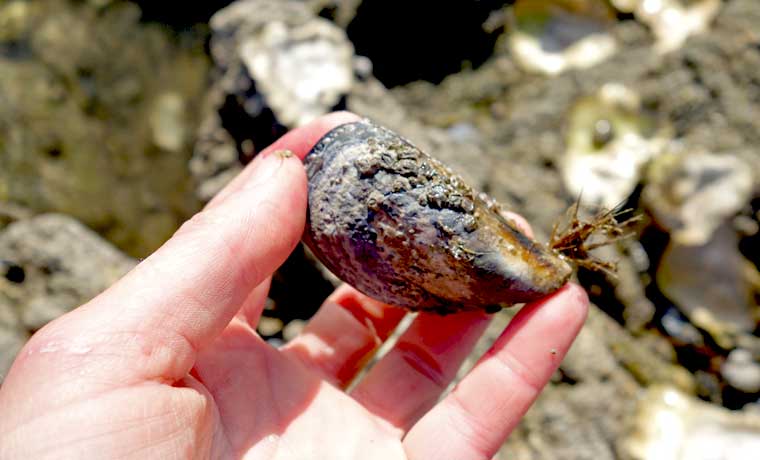
04Choose the right mussels
When you are presented with a whole beach full of mussels it’s easy to just grab your fill from the most accessible area. But not all mussels are suitable for foraging to eat.
- Only pick mussels that are closed – open mussels that are still attached to the rock are usually dead and are not suitable for eating.
- Pick the big ones – bigger mussels are usually more tender and tasty than smaller ones. Plus, leaving the smaller ones gives them more time to grow and breed, making the process more sustainable.
- Spread your harvest – to minimise your impact on the mussel bed in which you are foraging, try to pick from several different areas. Pick a couple here and a couple there and then move to another spot. Doing this also means that you explore the coastline a little bit more. You may even want to consider snorkelling down to get the biggest mussels if you find a good supply below the surface.
05ONLY HARVEST WHAT YOU NEED
No more needs to be said about that!
A step by step guide to foraging for mussels
Once you’ve found a great spot to go foraging for mussels and you know the tides will work in your favour, all that’s left to do is get picking!
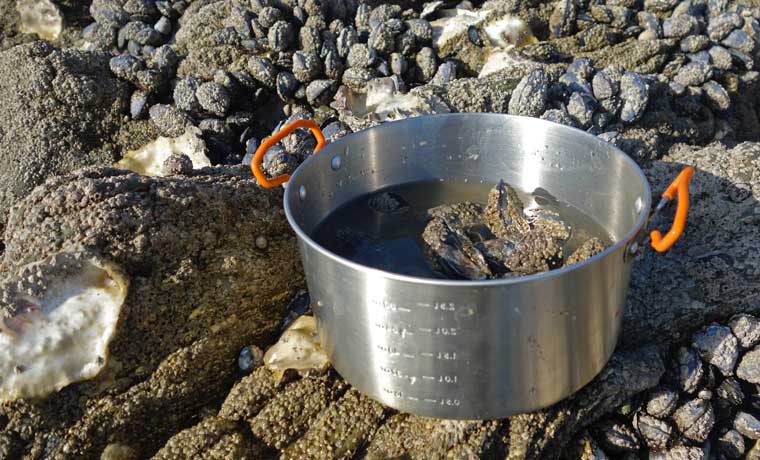
Step 1: collecting mussels
Prize the mussels off the rock using your hands. If they are being stubborn then you may need to use a knife. Take care not to damage them as you pick them as they will die, making them inedible.
Collect them in a bucket or pan of sea water.
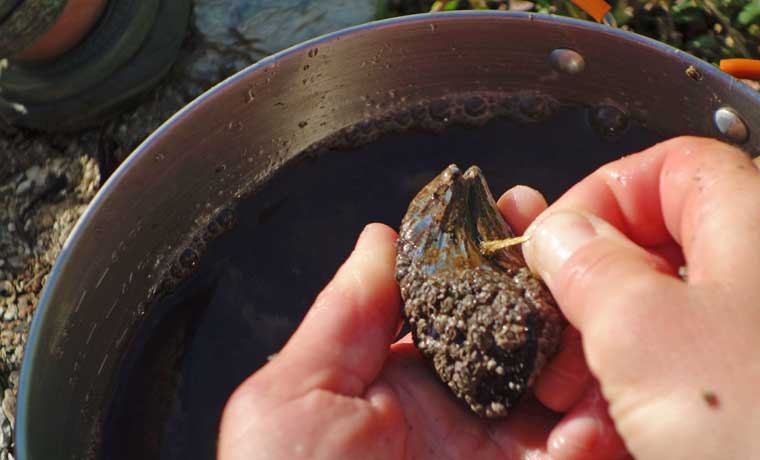
Step 2: cleaning mussels
Cleaning mussels is a fairly time consuming process. A pan full can take around half an hour to clean, but this depends on how many barnacles are attached to the shells.
Trim the beards
Most mussels have hairy ‘beards’ that need removing before you cook them. Some of the beards may have come off when they were picked, but mostly they will remain attached for you to remove. To remove them, simply grab the beard with your fingers and pull it firmly towards the narrow end of the mussel where the two shells meet at a hinge. It should come away easily. However, if it doesn’t then you may need to use a knife.
Remove any barnacles
Larger mussels often have lots of barnacles on. Though time consuming, removing them is a small price to pay for their meaty goodness of the mussels inside. They come off most easily by being scraped with a knife. Again, be careful not to damage the shells when doing this.
Scrub the mussels
Once the beards and barnacles have been removed, you may need to give the mussels a scrub in clean water to remove any excess bits of barnacle, beard, sand or seaweed.
Soak the mussels
Mussels feed by filtering water that comes into their shells. This means that there will be small amounts of waste inside their shells. To purge all the impurities that are left there you’ll need soak the mussels in fresh water for around 15 mins.
After the mussels have soaked, all the impurities will be left at the bottom of the pan. So be sure to lift the mussels out of the water, as draining the water out will just re-cover the mussels with unclean water.
NOTE: prolonged exposure to fresh water will kill mussels. So if you don’t intend on cooking your mussels immediately you should place the mussels in a pan of freshwater, add table salt to the pan, and soak for a couple of hours or until needed.
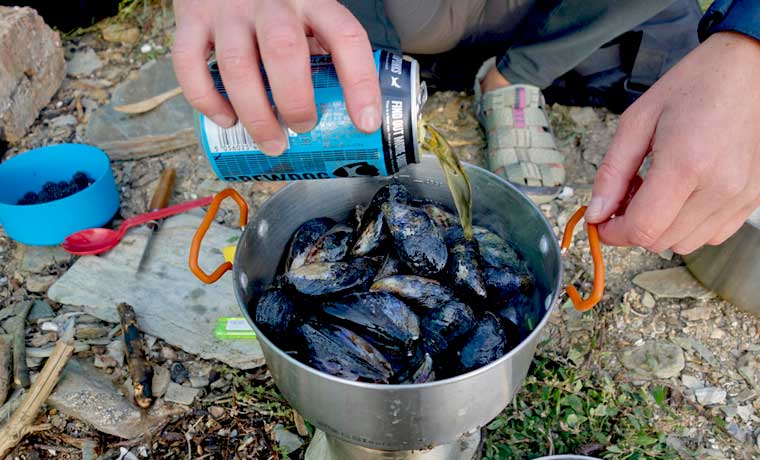
Step 3: cooking mussels
Once you have removed the mussels from the soaking water, check that none of them have become damaged during the cleaning process. If they have then discard them.
If any of them have opened up slightly then give them a little tap. If they close up then they’re still alive and are good to be cooked. But if they stay open then the mussel has died and should be discarded. Now you can get cooking!
Recipe: Ale and ginger camping mussels
I used this recipe on a recent paddle board camping trip. I was limited on packing space, so I opted for a can of beer instead of a bottle of wine. I also used garlic oil instead of butter and fresh garlic – this made preparation easier as well as minimising the potential mess of melted butter in my dry bag! But you can play around with flavours: cream, fresh herbs and white wine all work nicely. Just make sure there is enough liquid in the bottom of the pan to steam the mussels. But not too much: the mussels should have room to move around, so the pan should be no more than half filled with liquid.
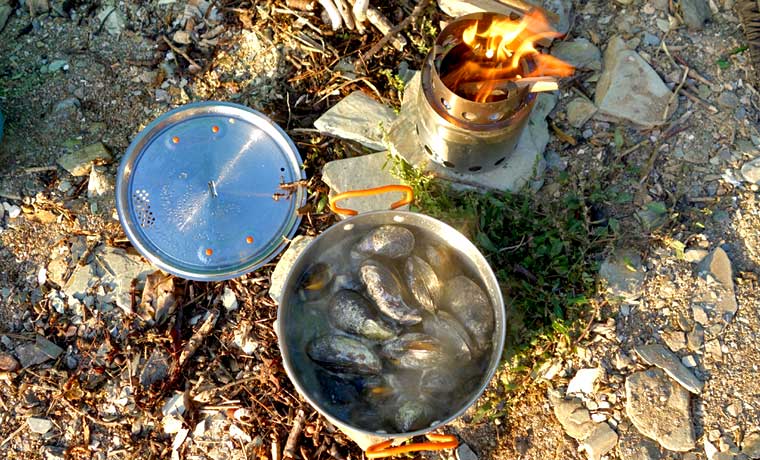
Serves 2
Ingredients
- 1 large pan of cleaned and soaked mussels
- 2 tbs garlic oil
- Thumb of ginger – finely diced
- ½ can of ale (or more if you like it strong!)
- ½ cup of water (adjust this to the size of your pan)
- Large handful of roughly chopped spinach or kale (I used sea spinach foraged from the shore)
- Juice of half a lemon
Method
- Heat the oil in a large pan then add the ginger. Cook until starting to brown.
- Add the mussels, water and beer to the pan, turn up the heat and cover the pan with a lid.
- Once the pan starts to steam, continue to cook for another 3-4 minutes, shaking the pan every now and then.
- The mussels are ready to be served once they have opened up.
- If any of the mussels are still closed after cooking then they should be discarded unless they can be opened easily.
- Squeeze the lemon juice over the mussels and serve with a hunk of bread.


